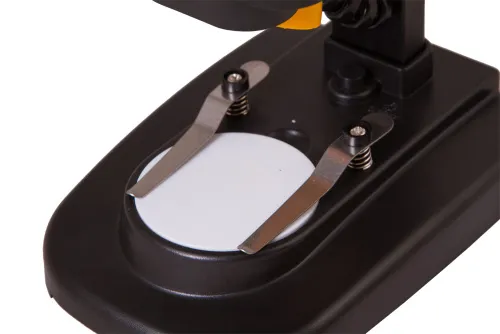Bresser National Geographic 20x Stereo Microscope
Microscope for kids. 3D image. 12 minerals for study. Magnification: 20x
Binocular
The microscope head is a core element of the microscope that you look through to see a magnified sample
20
How much the size of a sample increases when you observe it through a microscope
Elementary, school/educational
Application and use of the microscope
| Product ID | 69365 |
| Brand | Bresser GmbH, Germany |
| Warranty | 2 years |
| EAN | 4007922003719 |
| Package size (LxWxH) | 26x16x13 cm |
| Shipping Weight | 0.72 kg |
Description
This is what distinguishes any stereoscopic microscope: it renders 3D images of observed objects. Bresser National Geographic 20x Stereo Microscope is best suited for studying large and medium objects: insects, minerals, and leaves. Binocular head, 20x magnification, and lightweight and compact body make this device the best companion for spending time outdoors and studying any sample right on the spot. It is also equipped with an interpupillary distance adjustment mechanism. The specimens kit includes 12 minerals for study.
Features:
- Stereomicroscope for beginners
- Binocular head
- LED illumination
- 20x magnification
- Adjustable interpupillary distance
- Samples of minerals for study
The kit includes:
- Bresser National Geographic 20x Stereo Microscope
- 2xWF10x Eyepieces
- Minerals (12pcs)
- User manual
Specifications
| Product ID | 69365 |
| Brand | Bresser GmbH, Germany |
| Warranty | 2 years |
| EAN | 4007922003719 |
| Package size (LxWxH) | 26x16x13 cm |
| Shipping Weight | 0.72 kg |
| Type | light/optical, stereo/instrumental |
| Microscope head type | binocular |
| Optics material | optical glass |
| Magnification, x | 20 |
| Eyepieces | WF10x (2 pcs.) |
| Objectives | 2x |
| Focus | coarse |
| Illumination | LED |
| Power supply: batteries/built-in battery | 2 AA batteries (not included) |
| User level | beginners, elementary |
| Application | elementary, school/educational |
| Illumination location | upper |
| Research method | bright field |
| Experiment kit included | ✓ |
Reviews
Frequently Asked Questions – Microscopes (20.04.2020)
We have gathered answers to the most frequently asked questions to help you sort things out
We have gathered answers to the most frequently asked questions to help you sort things out
Eye under a microscope: insects’ photo (20.04.2020)
Find out why studying eyes under a microscope is entertaining; how insects’ and arachnids’ eyes differ and what the best way is to observe such an interesting specimen
Find out why studying eyes under a microscope is entertaining; how insects’ and arachnids’ eyes differ and what the best way is to observe such an interesting specimen
What does hair look like under a microscope? (17.05.2020)
Read this review to learn how to observe human hair, what different hair looks like under a microscope and what magnification is required for observations
Read this review to learn how to observe human hair, what different hair looks like under a microscope and what magnification is required for observations
How does the aperture of a microscope objective lens work? (17.05.2020)
Learn what a numerical aperture is and how to choose a suitable objective lens for your microscope here
Learn what a numerical aperture is and how to choose a suitable objective lens for your microscope here
A spider under a microscope: photos and peculiarities of studying the slide (18.05.2020)
Learn what a spider looks like under microscope, when the best time is to take photos of it, how to study it properly at magnification and more interesting facts about observing insects and arachnids
Learn what a spider looks like under microscope, when the best time is to take photos of it, how to study it properly at magnification and more interesting facts about observing insects and arachnids
What does a microscope consist of? (18.05.2020)
This review for beginner explorers of the micro world introduces you to the optical, illuminating and mechanical parts of a microscope and their functions
This review for beginner explorers of the micro world introduces you to the optical, illuminating and mechanical parts of a microscope and their functions
Paramecium caudatum - your first friend from the microworld (21.11.2016)
Short article about Paramecium caudatum - a microorganism that is interesting to observe through any microscope
Questions and Answers
Submit your question/feedback














